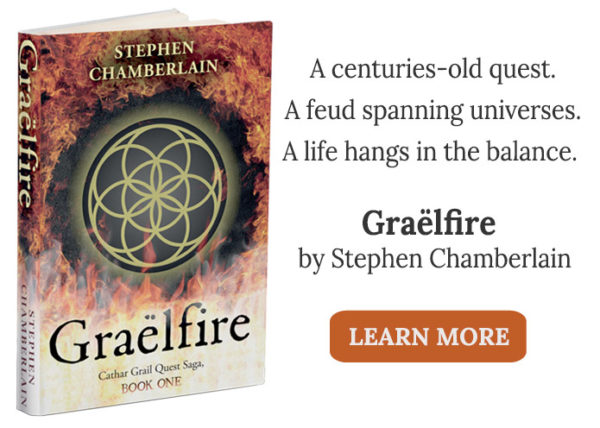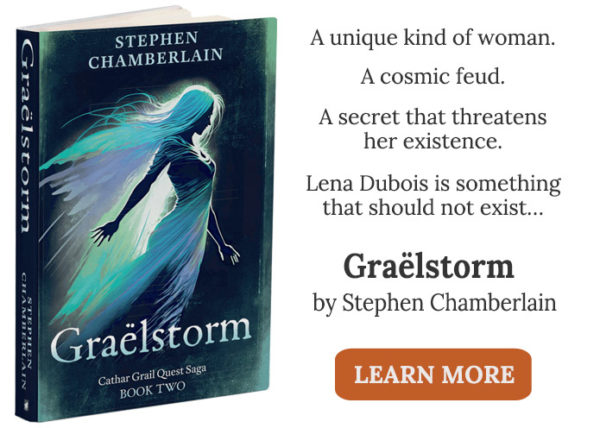“If history were taught in the form of stories, it would never be forgotten.”
– Rudyard Kipling
Historical fiction combines made-up characters and plots with real people, places, or events from the past. The genre encompasses a diverse range of stories, including action, romance, horror, and mystery. This provides readers the opportunity to experience different eras through thrilling and immersive stories.
I’ve been hooked on history ever since I was young. My bookshelves are stacked with novels that transport me back in time—works like Shōgun by James Clavell, Credo by Melvin Bragg, The Cadfael Chronicles by Ellis Peters, as well as Bernard Cornwell’s Saxon, Grail Quest and Sharpe series. My fantasy novel has a foot in this camp as well. It features intertwined threads: one is a Grail quest set in 13th-century France and Italy; the other is a modern-day quest in Switzerland.
Insight vs Hindsight
When I talk about historical fiction, I mean stories that are set in the writer’s past, such as Umberto Eco’s medieval murder mystery The Name of the Rose, and the TV series Vikings. These differ from novels written in the past by authors who lived through those times, like Jane Austen, Thomas Hardy, and most of Charles Dickens’s works. Both kinds make great period dramas, but their perspective is different. Recreating the past from the present requires research to accurately portray the era, while authors like Austen and Dickens wrote about the worlds they saw and experienced.
Accuracy
I think all writers want their audience to believe in the worlds they create. However, historical books and movies differ in accuracy. Some, like the movie Schindler’s List stick close to the essentials; others take more creative licence. For example, action films like Braveheart and The Last Samurai often bend the truth to add drama and excitement. Some people don’t mind stories that play fast and loose with the truth. Others find it off-putting. The key is balancing fact with fiction. Detail overload can be boring and slow down the pace of a story. Taking too many liberties and altering facts can diminish its believability.
I appreciate authors going the extra mile to include accurate details when their stories are inspired real-life events and people. It makes the narrative more believable and engaging, especially where the history is well-known or easily verified. That said, it’s okay to speculate on what might have been where history is poorly documented or to fill in gaps in the records. Ultimately, the level of accuracy will vary based on the author’s understanding of their audience’s expectations and the type of story being told.
When I began writing Graëlfire, I hadn’t planned on setting part of the story in the past. However, my mentor advised that using a prologue or flashbacks wouldn’t do justice to the story or its characters, because the past and present plots were so closely connected. You can find out more about our discussion and how I wove the two storylines together . The dual timelines technique proved a perfect fit for Graëlfire. I alternated the two threads, revealing clues in one era to shed light on mysteries in the other. This allowed me to explore how past events impacted the present-day plot and help readers piece everything together.
The challenge and enjoyment of writing the historical thread was creating a convincing portrayal of the medieval Cathar sect and their Catholic oppressors. Before I even started writing, I dedicated months to researching the Cathars’ gnostic beliefs, traditions, and history. However, I didn’t want the narrative to become bogged down, so I included just enough detail to bring the story to life and explain the characters’ motivations. Revealing the rest through the characters’ thoughts, dialogue, and reactions was way more entertaining than dumping all that information into blocks of explanatory text. It keeps the plot moving and is more engaging for the reader.
Authenticity
Accuracy and authenticity are related but separate concepts. Accuracy is about how closely the story sticks to the historical record, while authenticity is about making the past feel real and believable. Accuracy is objective—it’s about following the facts—whereas authenticity is subjective. It’s how well the writer evokes an impression of the period in the mind of each reader by giving them an experience of what life was like for people then. Both concepts are crucial in historical fiction, but while there is some leeway for inaccuracies, it’s harder to compromise on authenticity. Anything that doesn’t fit the period needs to be picked up before going to print, whether it’s language, artifacts, technology, or social customs. Anachronisms can shatter the reader’s , breaking the spell that keeps them immersed in the period the writer has recreated.
To give readers a true sense of the past, writers need to research the period in which their narrative is set. When writing my novel Graëlfire, I had to dig deep into thirteenth-century and explore the realities of daily life, especially for those heading out into the unknown where harsh weather and lack of food awaited. I had to figure out how two fugitives fleeing the Inquisition could travel safely on foot from Southern France to Northern Italy and evade capture. Which routes would they choose? How long would it take? How would they avoid attracting unwanted attention? Where did they sleep? What did they eat? What dangers and obstacles would they face? How would they have coped with sickness or injury? All these elements are essential, because they shape a character’s motivation, decisions, and mindset. To create believable historical settings, writers should also involve all their characters senses—what they see, hear, smell, taste, and touch. These details, along with references to historical events, help make the past come alive. But there are limits to authenticity. For example, accurately portraying how people talked in the past can be challenging. Try reading Chaucer’s Canterbury Tales or any of Shakespeare’s plays, and you’ll see how jarring old-style vernacular can be for us today. I opted to phrase dialogue in plain modern prose, occasionally adding authentic terms to convey the historic vibe.
Historical fiction uses bygone settings and events as a backdrop for the writer’s imagination. Most readers will overlook minor inaccuracies if the details are authentic and the story sweeps them away. Historical novels and movies aren’t meant to serve as textbooks or documentaries. Their purpose is to entertain us with focus, drama, conflict, and dialogue. The goal is to not just to transport us to the past but to make it intriguing and fun through well-crafted plots and creative writing.



